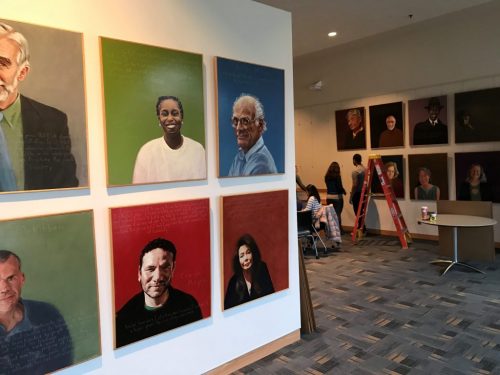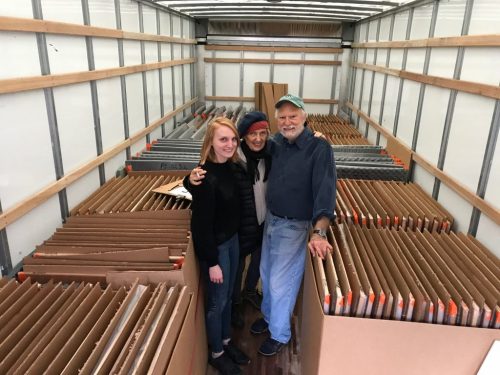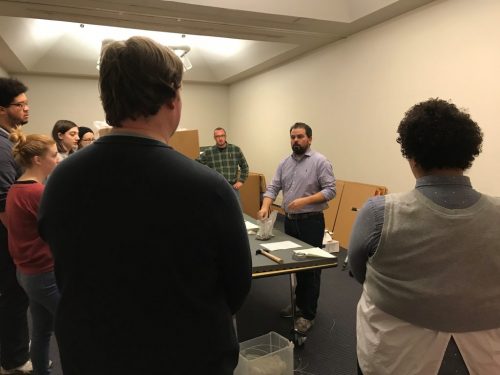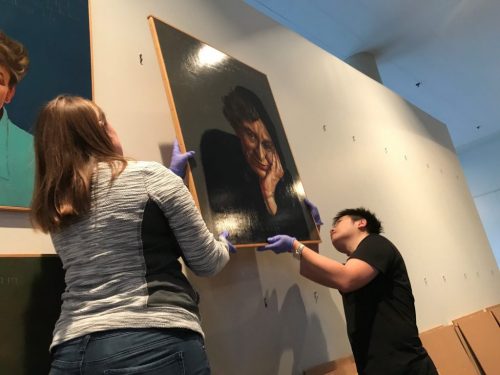Hannah Barber hopes to be a collections manager after her December 2018 graduation from the Graduate Program in Museum Studies in the College of Visual and Performing Arts’ (VPA) School of Design. Thanks to the University’s Robert Shetterly exhibition, she is ready for the position post-graduation.
Through an independent study course advised by Andrew Saluti, assistant professor and program coordinator in the museum studies graduate program, Barber is the collections manager for the “Americans Who Tell the Truth: Models of Courageous Citizenship” exhibition on display Nov. 29-Dec. 14 in the Schine Student Center’s Panasci Lounge.

Sponsored by the Maxwell School’s Tanner Lecture Series for Ethics, Citizenship, and Public Responsibility in cooperation with the University Lectures, the Syracuse exhibition is the first time that all 238 pieces in Shetterly’s portrait series will be displayed publicly in one location. It’s a massive undertaking, with Barber charged with the care and display of the collection.
“This experience is really valuable and unique because I would never have the opportunity to go and see the full process happen with a regular internship,” says Barber. “I was there for the discussion and design, going to get the artwork, meeting the artist and making that connection. I’m seeing the whole process, which is rare.”
“It’s a big thing to ask a graduate student to manage this kind of project,” says Saluti, speaking of Barber. “To be able to say you managed a project with this level of coordination—the travel, the over 230 objects—that’s not only a professionally wonderful exercise for her, but it’s the kind of real-world, hands-on experience our program tries to give our students.”
Beginning the journey of bringing the portraits to campus, Barber and Saluti rented a 26-foot box truck on Nov. 1 and drove about 10 hours to Portland, Maine. Their destination was Shetterly’s home, a bit further up the coast, where the portraits were being stored. Loading all of the portraits was a two-day project that took the efforts of Barber, Saluti, Shetterly and Shetterly’s wife. Adding to the fun, a documentary film producer, SU alumnus Richard Kane ’72, was on hand, capturing footage for a film project about Shetterly, “Our Children’s Future: A Portrait of Robert Shetterly.”

Barber and Saluti brought with them a case of packing tape, 10 rolls of 100-yard plastic sheeting, commercial-rated cardboard shipping boxes and full sheets of two-inch foam to ready the portraits for transit. To prepare for the portrait pick up, they created a customized object management database. On Day One in Maine, Barber used the database to inspect each piece, report on the condition of it, and set the foundation for its tracking throughout the whole process. After meticulously reporting on each piece, the group of four prepped the portraits in Shetterly’s basement. They spent 10 hours carefully wrapping and taping each portrait with a brief 30-minute break for lunch. The second day, after three more hours of wrapping and taping, the paintings were carried upstairs to the waiting truck. As the portraits were loaded in, and rain poured down, emotions overcame Shetterly.
“[Shetterly] was slightly tearing up and couldn’t believe that we were finally at this point,” says Saluti. “It was just finally hitting him that this was actually happening.”
Being responsible for the first all-encompassing exhibition of Shetterly’s landmark collection is a responsibility and privilege Barber takes seriously. “This exhibition is really important because it has been Rob’s main focus for the past 20 years of his life,” she says. “It’s huge to see it all together … and have an entire space to show what he has been doing.”
Bringing the Shetterly exhibition to Syracuse has been a multi-year effort involving an organizing committee and multiple departments across the University. Among those leading the project is Jim Clark, professor of theater management and program coordinator in the Department of Drama in the College of Visual and Performing Arts.
Last winter, after it was decided that the exhibition would come to campus, Clark reached out to Saluti about designing a space that could house the 238 portraits. Having to think outside of the prepared blank walls of a museum, a few potential locations were proposed, with Goldstein Auditorium as a frontrunner option. Taking floor plans of the area and drawing an accurate 3-D model of the space using SketchUp, Saluti drafted a design by manipulating the entire space—and the outer hallway—to accommodate all the pieces.
Then, due to unforeseen circumstances, the location needed to be changed.

After consulting with Physical Plant, Student Centers and Programming Services, and the Office of Special Events, Saluti proposed Panasci Lounge as the next best location. The idea presented some new concerns.
“For Panasci, the biggest challenges were working with the existing architecture of the space and acknowledging the use,” says Saluti. “The lounge is still an active study center, and this exhibition happens to fall during the two final weeks of the semester, a busy time for the space.”
Still, Panasci Lounge was deemed workable. In fact, coupling the exhibition with the student lounge space presented opportunity for engagement and visibility that other spaces could not provide. Once the location was confirmed, the gallery space needed to be designed—a significant task given the sheer number of pieces and the vast amount of wall space required. During the countless hours spent redesigning the exhibition space, Saluti found himself innovating and creating in ways that an ordinary exhibition would not need. The most significant of the innovations was the realization that custom walls would need to be built and installed in Panasci Lounge on a temporary basis, through the run of the exhibition.
The idea of the pop-up exhibit outside of the traditional museum walls is increasing with popularity around the world. Therefore, the real-life application of the Shetterly exhibition design and implementation process is not a missed lesson on the museum studies graduate students.
“The students have to take what they’ve learned and know about the best practices of handling, installing and managing the objects and employ that in a nontraditional exhibition environment, which to me is a wonderful exercise,” says Saluti.

The construction of the gallery took place Monday, Nov. 26, and Tuesday, Nov. 27. The installation relies on volunteer help, primarily from the 33 students in the museum studies graduate program. Sharing this experience with her cohorts is what excites Barber the most about the project.
“This project takes a lot of hands, and I love getting to know my classmates more intimately,” she says. “In this field, you lean on each other a lot. A lot of people wear a lot of hats and therefore must be multi-skilled. You learn a lot from each other, build off each other and help each other.”
